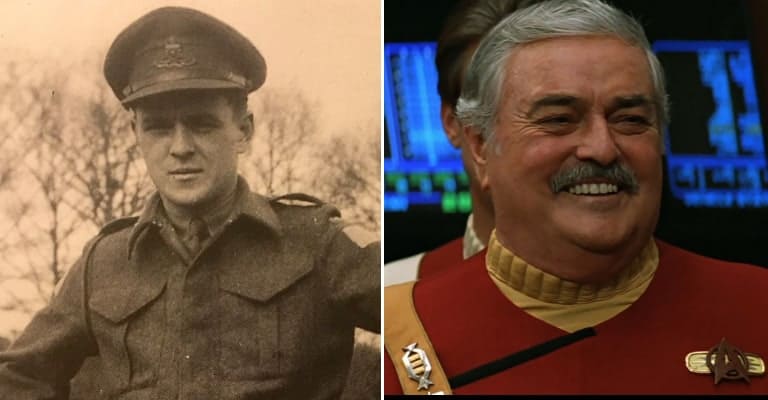“Beam me up, Scotty” is probably Star Trek’s most iconic phrase, instantly conjuring up the Enterprise’s miracle worker chief engineer, who commanded the spaceship and recorded its log when the captain and first officer were absent. The franchise’s second most memorable phrase is probably “I’m giving it all she’s got, captain! She can’nae take any more!“, delivered in a thick Scottish burr by the Enterprise’s engineer.
In real life, James Montgomery Doohan (1920 – 2005), the actor who played Montgomery “Scotty” Scott, did not have a Scottish accent, and was not even from Scotland. Instead, Doohan was a Canadian who had earned a reputation as the most versatile voice actor in the business before he was cast for his defining role in Star Trek. Before he took up acting, however, Doohan had been a real life, honest to goodness, World War II badass who personally killed Nazis in combat, was struck by bullets multiple times on D-Day, and had a middle finger shot off.

From Science Nerd to Hitting the Beach on D-Day
Doohan was the youngest of four children born to Irish immigrants in Vancouver, British Colombia. His mother was a homemaker, while his father made a living as a dentist, veterinarian, and pharmacist who owned and operated a chemist shop. Doohan’s dad was an enterprising and talented amateur scientist, who reportedly invented an early form of octane gas in 1923. However, he was also a serious alcoholic, and the heavy drinking got in the way of success, and kept him from following up on his discovery and cashing in.
Jimmy Doohan took up after his father in his love of science, and enrolled in a technical high school where he excelled at science and mathematics. He also joined the Royal Canadian Cadet Corps – Canada’s version of high school ROTC – in 1938. The Second World War kicked off a year later, and Doohan went from playing soldier in high school to the real thing, joining the Royal Canadian Artillery early in the conflict. He was first assigned to the 2nd Canadian Infantry Division’s 14th (Midland) Field Battery, before he was commissioned as a lieutenant and assigned to the 3rd Canadian Division’s 14th Field Artillery Regiment.
His unit was shipped to England in 1940, where the Canadians spent the next few years garrisoning the British Isles against a German onslaught, and training for an eventual invasion to retake Europe from the Nazis. Other than for a failed raid on Dieppe in 1942 that turned into a catastrophe, and which Doohan luckily missed, the Canadian ground forces saw next to no combat. Eventually, they started getting antsy after years of constant training with little action, and from the snide comments directed their way, sarcastically referring to them as “the world’s best trained soldiers“.

Doohan and the Canadian ground formations finally got their first taste of combat in the Normandy Invasion, when they landed at Juno Beach on D-Day, June 6th, 1944. They were supposed to land in the predawn darkness, but rough sea conditions ended up delaying their amphibious assault until well after sunrise on D-Day. Doohan and his comrades were undaunted, and years later, he described the experience of being on a landing craft as it approached the enemy shore: “We were more afraid of drowning than we were of the Germans“.
He had cause for confidence, as the superbly trained Canadians turned out to be more than a match for the German defenders. However, it was no cakewalk. For one thing, the invasion planners had overestimated the effectiveness of heavy aerial bombardment that had targeted the beaches in the days and weeks leading up to the invasion. It was assumed that the aerial raids would have destroyed or seriously damaged the German fortifications, and inflicted such heavy losses so as to enable the attackers to advance against relatively little opposition. Those estimates turned out to be overly optimistic, and things did not work out quite that way on the actual day of battle.

